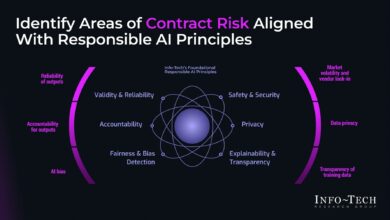How Generative AI is Transforming Financial Industry

Today’s financial industry is experiencing a significant shift due to the enhancing role of technology. Of these, generative AI is the most radical one, as it opens up new possibilities for business development and growth. Generative AI is the subfield of artificial intelligence concerned with the generation of new content and data. It is gradually transforming all facets of finance, ranging from customer support to fraud prevention and detection, among others. This article identifies how Generative AI is transforming Financial Industry.
Understanding Generative AI
Generative AI, on its part, encompasses systems that can identify new data, text, images, voice, and other inputs that have not been fed into the algorithm before. In contrast to generative AI, which is more limited in its objective as it learns to identify and make choices based on patterns from the data collected, generative AI can produce new content that was not previously in existence. Technological advancements like Generative Adversarial Networks (GANs) and Variational Autoencoders (VAEs) are the primary enablers of such innovation where machines can learn and create realistic outputs.
1. Fraud Detection and Prevention
The use of Generative AI is transforming financial industry, and fraud detection is one of the most important contemporary trends. In traditional approaches, decisions are made based on specific patterns and previous antecedents of fraudulent translations. Nevertheless, it can be disappointing to note that these methods are relatively ineffective in identifying new and more elaborate fraud schemes. Generative AI can quickly work through analyzed transactions and generate specific scenarios mirroring how various fraud patterns may be embedded. Through constant training and application of knowledge, these systems can pinpoint peculiarities and, therefore, make accurate reports of the suspected movement.
2. Risk Management
One of the multiple fields where generative AI has been witnessing advancements is risk management. Market risk refers to risks associated with volatile market prices. It is often mitigated through hedging instruments, while credit risk covers the probability of the other party failing to meet the obligations and involves the use of credit derivatives. The Generative AI is Transforming Financial Industry and can run extensive samples of the market and unique situations to get a profound understanding of diversified risks and how they affect a portfolio most; when highly realistic and diversified, the example scenarios depict adverse events in an economic institution to greater detail and depth hence improving on the strength of the techniques used to mitigate the risks involved.
However, in a credit scoring model, learning, generative AI can improve the score by generating data for the lower minority class. This plays a preferred role in enhancing both precision and fairness in credit risk evaluation, which in turn minimizes cardboard and boosts credit accessibility.
3. Algorithmic Trading
Algo trading is the process whereby trades are made for an asset or equity utilizing an algorithm in the shortest time possible and with little interference from a human being. This type of AI can enhance the decision-making of algorithmic trading by creating realistic scenarios and data on the market to help in training and evaluating the seller’s algorithms. It could mimic a variety of market situations so traders can work out and hone their strategies that are suitable for given markets or states.
In the same way, generative AI can generate other models, such as a forecast that predicts the market’s movements according to old records and updated information. This helps traders be more informed in their decision-making and in a better position to take advantage of rising opportunities in the market.
4. Customer Service and Personalization
Due to the advancements in generative AI, the future of customer service in the financial sector is bright as it can offer continuously improving and more specific interactions. Chatbots and virtual assistants that apply generative AI can better understand the context and provide appropriate answers, whereas the former is beneficial for developing an optimized search algorithm. These systems can produce normal language, as other people do; this will make the customers feel satisfied with the services.
Moreover, generative AI also allows the creation of unique financial products and services based on customer data information. For example, it can recommend investment offers, loans, and savings schemes according to the customer’s specific data. To achieve this level of differentiation, Personalization offers the marketing strategies of Need, Solution, Persona, and Personal data so that financial institutions can get closer to their customers and increase loyalty.
5. Document Processing and Analysis
Today, companies and other financial institutions sign hundreds of contracts, prepare reports and statements, and generate various forms. Existing documents such as contracts, agreements, policies, and reports can be processed and analyzed through generative AI, which significantly decreases the time spent on these monotonous, tedious works. NLP technology allows AI systems to parse the text to capture data and content, sum up, and even compose messages.
Firstly, generative AI can be applied in the creation of compliance reports in a company as it enhances the timely production of reports and helps them conform to industry standards. This is not only beneficial in terms of efficiency but also helps eliminate human mistakes that may be fatal.
6. Financial Forecasting and Planning
Specifically, financial forecasting and planning are essential to enhancing financial institutions. These processes can be improved by using generative AI, which can create models that consider various factors that could affect the outcome of a particular task or project. These can include future market position and condition, as well as customers’ behaviors, which can aid in strategic planning.
This is true given that Generative AI can also help with budgeting by creating futuristic and realistic goals. This makes it easier for organizations to provide resources and predict problems that may arise and their advantages.
Conclusion
Generative AI is Transforming Financial Industry and its characteristics in terms of the methodology that is used in the industry, and it is also changing the ways in which people interact with the objects that are rooted in the financial sector, for example, with financial products or services. Technology has the advantages of boosting efficiency, increasing accuracy, and having a more significant number of innovations. Still, they have specific barriers that have to do with the protection of personal information, compliance with the requirements of various regulators, and model explainability to get the most out of generative AI.
Thus, the future of generative AI applications in the field of finance promises to remain successful in the continuous improvements in the domains of customer insight, real-time decision-making, risk management, and the use of blockchain. It points to the possibility of ethical approaches in the application of generative AI for consumers, financial institutions, and the overall financial industry, where social responsibility, innovation, growth, and customer satisfaction are the primary objectives.
FAQs
What is generative AI?
Generative AI is a type of artificial intelligence that can produce new content such as text, images, audio, and video by learning patterns from existing data. It uses machine learning algorithms to create original outputs based on the training data rather than just analyzing or classifying existing information.
How does GenAI differ from other forms of artificial intelligence?
The critical difference between generative AI and traditional AI is that generative AI can create new content, such as text, images, audio, and video, by learning patterns from existing data. In contrast, traditional AI is focused on analyzing data and performing specific tasks based on predefined rules and patterns.
How is generative AI being used in the financial industry?
Generative AI is being widely adopted in the financial industry to automate tasks, enhance customer experiences, detect fraud, improve risk assessment and credit scoring, generate financial reports and forecasts, and optimize portfolio management.
What are some examples of generative AI applications in finance?
Examples of generative AI applications in finance include automating financial document monitoring, fraud detection, personalized customer experiences, and generating financial reports such as balance sheets, income statements, and cash flow statements. Additionally, generative AI is used for risk assessment, algorithmic trading, and portfolio management, enhancing operational efficiency and decision-making in the financial sector.
What are the benefits of using generative AI in financial services?
The key benefits of using generative AI in financial services include automating manual tasks to improve efficiency and productivity, enhancing customer experiences through personalized services and recommendations, detecting and preventing fraud more effectively, and enabling better risk assessment and financial forecasting by analyzing large datasets.



